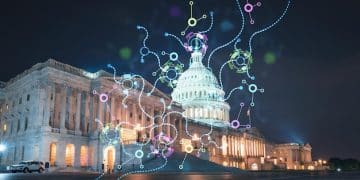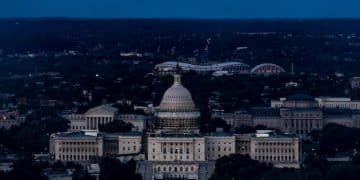US Nuclear Non-Proliferation: 2025 Challenges & Opportunities

Advertisements
The United States’ approach to nuclear non-proliferation in 2025 is a complex tapestry of diplomacy, deterrence, and technological adaptation, striving to mitigate the spread of nuclear weapons amid evolving geopolitical landscapes and emerging threats while leveraging opportunities for international cooperation and Arms control advancement.
Advertisements
Understanding the US Approach to Nuclear Non-Proliferation: Challenges and Opportunities in 2025 is crucial as the global security landscape undergoes significant shifts. The United States, a pivotal player, faces a dynamic environment where traditional diplomatic tools intersect with new technological realities and geopolitical rivalries. This intricate balance requires not only a firm stance against proliferation but also innovative strategies to build consensus and maintain stability.
The Evolving Geopolitical Landscape and US Non-Proliferation
The global security environment in 2025 is starkly different from previous decades, presenting both daunting challenges and nuanced opportunities for US nuclear non-proliferation efforts. Traditional power dynamics are shifting, with the emergence of new players and the resurgence of established ones, all impacting the efficacy of arms control regimes.
Advertisements
One of the primary challenges stems from the increased assertiveness of revisionist states and the erosion of multilateral norms. These actors often operate outside established non-proliferation frameworks or seek to undermine them, complicating verification and enforcement mechanisms critical to preventing the spread of nuclear weapons. This makes the US strategy of deterrence and diplomatic engagement particularly vital, albeit more complex, in the current era.
Rising Nuclear Ambitions and Regional Instability
Several nations continue to pursue or expand their nuclear capabilities, driven by perceived security threats, regional rivalries, or a desire for increased international standing. This pursuit often unfolds in regions already prone to instability, creating a volatile mix that could quickly escalate.
- Regional conflicts heighten the risk of conventional warfare escalating to include nuclear threats.
- The desire for nuclear deterrence among some states fuels a dangerous arms race dynamic.
- Lack of transparency in particular nuclear programs complicates international monitoring and trust-building efforts.
The Impact of Great Power Competition
Competition among major powers significantly influences non-proliferation. When leading nuclear states are at odds, it can undermine the collective will to enforce non-proliferation norms and can even foster an environment where other nations feel compelled to develop nuclear weapons as a deterrent against perceived threats from these major powers.
The US approach acknowledges that successful non-proliferation cannot occur in a vacuum; it is deeply intertwined with broader strategic stability. Dialogue and de-escalation mechanisms among great powers are thus indirectly, yet profoundly, critical to maintaining and strengthening the non-proliferation regime. This involves navigating complex diplomatic terrains while upholding core principles.
In essence, the US navigates a world where the lines between traditional and non-traditional threats blur, requiring a more agile and multifaceted approach to nuclear non-proliferation than ever before. This includes a heightened focus on intelligence, counter-proliferation measures, and adaptive diplomatic strategies.
Technological Advancements and Their Dual-Use Dilemma
The year 2025 finds the world at a crossroads concerning technological progress, especially regarding its implications for nuclear non-proliferation. While innovations offer remarkable benefits, they often carry a “dual-use” potential, meaning technologies developed for peaceful civilian purposes can also be repurposed for military applications, including nuclear weapons programs. The US strategy must therefore meticulously balance promoting beneficial scientific advancements with stringent controls to prevent diversion.
This dual-use dilemma is particularly pronounced in fields like advanced computing, artificial intelligence (AI), and additive manufacturing (3D printing). AI, for instance, can significantly accelerate weapon design, optimize delivery systems, and enhance targeting capabilities, making it a critical area of concern for proliferation experts.
Cybersecurity and Nuclear Proliferation Risks
The increasing digitalization of critical infrastructure, including nuclear facilities, introduces new vulnerabilities. Cyberattacks can disrupt operations, compromise safety systems, or even facilitate the theft of sensitive nuclear materials or designs. The US actively engages in bolstering cybersecurity defenses for its own nuclear assets and collaborates internationally to share best practices and threat intelligence. This partnership is vital given the global interconnectedness of digital systems.
- Cyber-physical systems controlling nuclear operations are potential targets.
- Data breaches of classified nuclear information could accelerate proliferation.
- The development of sophisticated cyber weapons could be asymmetric threats.
Emerging Technologies and Verification Challenges
New technologies, such as advanced sensor systems and enhanced data analytics, also offer opportunities for more robust verification of arms control agreements. These tools can improve the detection of undeclared nuclear activities and enhance confidence-building measures. However, their proliferation to non-state actors or states of concern could complicate the verification process, making covert activities harder to detect without superior technical capabilities. The US supports research and development in these areas to maintain a technological edge in monitoring.
The rapid pace of technological change necessitates constant adaptation in non-proliferation strategies. Outdated regulations or oversight mechanisms can quickly become ineffective. Therefore, the US approach emphasizes proactive engagement with the scientific community, international regulatory bodies, and industry to anticipate and address emerging challenges. This agile approach is critical to staying ahead of proliferating nations seeking to exploit technological loopholes.

Strengthening International Norms and Institutions
A cornerstone of the US non-proliferation policy in 2025 remains the unwavering commitment to strengthening international norms and institutions. These frameworks, meticulously built over decades, serve as the primary bulwark against the spread of nuclear weapons. The Nuclear Non-Proliferation Treaty (NPT) stands paramount, but its efficacy hinges on universal adherence and robust enforcement mechanisms. The US consistently advocates for the NPT’s integrity, emphasizing its three pillars: non-proliferation, disarmament, and the peaceful use of nuclear energy.
However, the global political climate often tests the resilience of these institutions. Instances of non-compliance or withdrawal from treaties can undermine collective security and encourage other states to reconsider their commitments. The US, therefore, prioritizes diplomatic engagement to reinforce the NPT and other vital agreements. This involves patient negotiation, multilateral dialogue, and, when necessary, coordinated international pressure.
The Role of the IAEA and UNSC
The International Atomic Energy Agency (IAEA) is indispensable for verifying compliance with non-proliferation obligations. Its inspectors and technical experts provide crucial assurances that nuclear materials and facilities are not diverted for military purposes. The US strongly supports the IAEA’s mandate, advocating for increased funding, expanded authority, and universal adoption of the Additional Protocol, which grants the IAEA broader inspection rights.
- IAEA’s verification capabilities are essential for building trust and transparency.
- The Additional Protocol provides enhanced legal authority for inspections.
- Sustained financial and political support for the IAEA is paramount.
The United Nations Security Council (UNSC) holds primary responsibility for maintaining international peace and security, including responding to proliferation threats. Its resolutions provide the legal teeth for sanctions and other coercive measures. The US works within the UNSC to forge consensus on how to address non-proliferation challenges, even when faced with vetoes or differing national interests. This requires skillful diplomacy to build broad coalitions in the face of complex geo-political divisions.
Arms Control Treaties and Disarmament Efforts
While the focus is often on preventing new states from acquiring nuclear weapons, the long-term goal of disarmament among existing nuclear powers remains crucial for reinforcing the non-proliferation regime. The US continues to pursue verifiable arms control agreements that reduce strategic arsenals and enhance stability. Such agreements demonstrate commitment to the NPT’s disarmament pillar, inspiring confidence among non-nuclear-weapon states.
In 2025, efforts to revive or extend crucial arms control treaties face significant headwinds, but they remain a high priority for US diplomacy. Furthermore, confidence-building measures, such as data exchanges and mutual inspections, are vital for reducing misperception and accidental escalation. The effectiveness of these measures rests on consistent communication and a shared commitment to transparency among nuclear powers, a difficult but necessary endeavor.
Addressing Regional Proliferation Hotspots
In 2025, several regional hotspots continue to pose significant challenges to nuclear non-proliferation, demanding tailored and nuanced US approaches. These regions, often characterized by deep-seated historical animosities and shifting alliances, require a delicate balance of diplomatic pressure, deterrence, and engagement. The US recognizes that a one-size-fits-all strategy is insufficient; rather, each hotspot presents unique complexities.
The Middle East, in particular, remains a region of acute concern, with ongoing tensions and the potential for rapid escalation. The US continues to monitor nuclear ambitions closely, working to prevent further proliferation through a combination of sanctions, security assurances to allies, and diplomatic initiatives aimed at de-escalation and regional dialogue. The goal is to avoid a nuclear domino effect that could destabilize the entire region.
Iran’s Nuclear Program and US Strategy
Iran’s nuclear program remains a central focus of US non-proliferation efforts. The US strategy combines diplomatic efforts to restrain Iran’s nuclear activities with robust deterrence and, when deemed necessary, economic sanctions. The overarching objective is to prevent Iran from developing nuclear weapons while seeking pathways for a peaceful resolution. This involves international coordination to ensure that any future agreements are verifiable and robust, preventing a breakout capability.
- Diplomatic engagement aims to roll back sensitive nuclear activities.
- Sanctions are used to exert pressure and limit access to proliferation-sensitive technologies.
- Regional security dialogues seek to build trust and reduce tensions.
North Korea’s Enduring Nuclear Threat
North Korea’s continued pursuit and advancement of its nuclear and missile programs represent one of the most intractable non-proliferation challenges. The US maintains a strategy that combines strong deterrence with intermittent diplomatic outreach, seeking denuclearization through multilateral negotiations. This approach acknowledges the long history of failed talks but remains open to credible pathways to verifiable disarmament.
The US also works closely with allies in the region, particularly South Korea and Japan, to enhance missile defense capabilities and strengthen conventional deterrence. This alliance solidarity is crucial for regional stability and for projecting a unified front against North Korea’s provocations. The emphasis remains on a complete, verifiable, and irreversible denuclearization, recognizing the significant security implications for the Indo-Pacific region.
Effectively addressing these regional hotspots requires sustained and agile US diplomatic engagement, complemented by strong intelligence gathering and robust security partnerships. The ability to adapt to fluid political dynamics while maintaining clear non-proliferation objectives is paramount to mitigating these significant global threats.
The Role of Bilateral and Multilateral Diplomacy
In 2025, the tapestry of US nuclear non-proliferation efforts is intricately woven with both bilateral and multilateral diplomacy. These twin pillars are indispensable for building consensus, enforcing norms, and finding cooperative solutions to complex proliferation challenges. While multilateral forums address global frameworks, bilateral engagements allow for tailored, nuanced discussions that can unblock impasses or build trust on specific issues.
Multilateral diplomacy, often conducted through the United Nations, the IAEA, and various non-proliferation initiatives like the Proliferation Security Initiative (PSI), provides a platform for setting global standards, sharing intelligence, and coordinating collective action. These platforms are crucial for addressing issues that transcend national borders, such as stopping illicit trafficking of nuclear materials or developing common export controls.
Building Coalitions and Consensus
A key aspect of US diplomatic strategy is the continuous effort to build strong coalitions and foster international consensus on non-proliferation. This involves engaging with traditional allies and seeking common ground with non-aligned states and even strategic competitors where shared interests in preventing nuclear spread exist. Consensus-building is particularly vital for implementing effective sanctions or for bolstering arms control regimes, where compliance hinges on widespread international support.
- Engaging diverse states on common non-proliferation objectives.
- Facilitating dialogue to bridge policy differences and build trust.
- Leveraging international forums for coordinated action and norm reinforcement.
Strategic Dialogues with Nuclear Powers
Bilateral strategic dialogues with other nuclear-weapon states, particularly Russia and China, are critical for managing nuclear risks and enhancing strategic stability. These discussions often focus on transparency measures, risk reduction, and the future of arms control. Despite broader geopolitical tensions, maintaining channels of communication on nuclear issues is paramount to preventing miscalculation and accidental escalation.
The US also engages in bilateral security assurances with non-nuclear-weapon states, particularly allies, to reduce their perceived need to develop their own nuclear capabilities. These assurances are a cornerstone of preventing further proliferation, demonstrating that relying on US extended deterrence is a more secure and stable path than pursuing a domestic nuclear arsenal. These commitments reinforce the NPT’s grand bargain and provide a strong disincentive for proliferation.
Ultimately, the effectiveness of US non-proliferation efforts in 2025 rests heavily on its ability to skillfully navigate global diplomatic terrain, leveraging both broad multilateral platforms and specific bilateral relationships to advance shared objectives of a world free from the threat of nuclear weapons.
Opportunities for Progress in 2025
Amidst the multifaceted challenges, 2025 also presents significant opportunities for advancing nuclear non-proliferation. The US strategy is not solely about containment and deterrence; it actively seeks windows for progress, leveraging diplomatic openings, technological innovations, and evolving geopolitical realignments to strengthen the global non-proliferation regime. These opportunities often arise from shared concerns about global stability or from moments of diplomatic convergence.
One notable opportunity lies in the growing recognition among diverse states of the catastrophic consequences of nuclear war, which can serve as a powerful unifying force. Even states with adversarial relationships can find common ground in preventing nuclear conflict, creating pathways for dialogue and de-escalation that benefit non-proliferation.
Technological Innovation for Verification and Monitoring
As previously touched upon, advancements in satellite imagery, artificial intelligence (AI) for data analysis, and remote sensing technologies offer unprecedented capabilities for verification and monitoring of nuclear activities. This presents an opportunity to develop more robust and less intrusive inspection regimes, enhancing trust and transparency, even when on-site access is limited.
- High-resolution satellite imagery improves detection of undeclared sites.
- AI can analyze vast datasets to identify proliferation signatures.
- Remote sensing technologies offer diverse data streams for monitoring.
The US actively invests in these technologies and seeks to share them responsibly with international monitoring bodies like the IAEA, thereby enhancing their capacity to detect and deter proliferation. This collaborative approach ensures that the benefits of technological progress serve the collective good of nuclear security. It also allows for more nuanced interpretations of activities that might otherwise be considered ambiguous simply due to lack of visibility.
Renewed Focus on Multilateral Cooperation
Periods of heightened global tension can paradoxically lead to a renewed appreciation for multilateral cooperation, as states realize that no single nation can address complex challenges like nuclear proliferation alone. The US has an opportunity to revitalize existing multilateral forums and initiate new dialogues that emphasize collective security and shared responsibility.
This includes exploring joint initiatives on nuclear security, such as securing vulnerable materials and preventing nuclear terrorism, areas where common interests often outweigh political differences. Furthermore, promoting peaceful uses of nuclear energy under strict non-proliferation safeguards can provide incentives for states to forgo weaponization, offering legitimate pathways for energy development. By presenting a collaborative vision for global nuclear energy safety and security, the US can champion responsible nuclear stewardship, transforming proliferation threats into opportunities for safe, secure, and sustainable energy development worldwide.

Challenges to Disarmament and Strategic Stability
While the US remains committed to the Nuclear Non-Proliferation Treaty’s disarmament pillar, achieving meaningful progress in 2025 is fraught with significant challenges. The concept of strategic stability, traditionally understood as preventing a full-scale nuclear exchange, is becoming increasingly complex. It is no longer solely about the strategic arsenals of the largest nuclear powers but also encompasses regional dynamics, emerging technologies, and the proliferation of delivery systems.
The arms control architecture, built largely during the Cold War, struggles to adapt to this new multi-polar environment. New types of weapons, such as hypersonic missiles and autonomous weapon systems, challenge traditional notions of deterrence and introduce uncertainties that could destabilize strategic relationships, complicating efforts to negotiate reductions in nuclear arsenals.
Lack of Transparency and Verification
A fundamental challenge to disarmament is the persistent lack of transparency among nuclear-weapon states regarding their arsenals and doctrines. Without clear, verifiable data, building the trust necessary for substantial arms reductions becomes exceedingly difficult. The absence of robust verification mechanisms for certain types of weapons or facilities further compounds this problem, fostering suspicion rather than cooperation.
- Secrecy surrounding nuclear stockpiles hinders arms control progress.
- Challenges in verifying new weapons technologies reduce confidence.
- Lack of data exchange prevents accurate threat assessments.
The Intersection of Conventional and Nuclear Deterrence
The lines between conventional and nuclear deterrence are increasingly blurred. Advances in conventional precision-strike capabilities could be perceived as threatening a nuclear-armed state’s second-strike capability, potentially lowering the threshold for nuclear use in a crisis. This dynamic complicates risk reduction efforts and requires careful strategic communication to prevent miscalculation. The US endeavors to calibrate its conventional military posture to avoid inadvertently fueling nuclear escalation, recognizing the delicate balance required.
Moreover, the rise of regional nuclear powers and the proliferation of longer-range missile technologies mean that strategic stability is no longer just a bilateral concern between the US and Russia; it is a complex, multilateral challenge. Addressing this requires broader dialogues that include emerging nuclear actors and focus on regional arms control measures, a daunting but essential task for global security. The US plays a crucial role in promoting these broader conversations, ensuring that all relevant actors are involved in shaping the future of nuclear stability.
The Future of US Non-Proliferation Policy
Looking toward the remainder of 2025 and beyond, the future of US nuclear non-proliferation policy is poised at a critical juncture. It will need to remain adaptable, resilient, and forward-looking, capable of navigating a rapidly evolving global security environment. The core tenets of deterring proliferation, strengthening international norms, and promoting disarmament will persist, but the methods and priorities will continually shift in response to new threats and opportunities. The emphasis will progressively lean more towards proactive engagement rather than reactive measures, especially given the accelerated pace of technological advancements and geopolitical realignments.
A key element of future policy will involve leveraging innovative technologies not only for verification but also for counter-proliferation efforts. This means developing sophisticated intelligence analysis tools, enhancing border security measures against illicit nuclear trafficking, and investing in advanced interdiction capabilities. Furthermore, the US will likely place greater emphasis on cyber deterrence and defense within the nuclear domain, recognizing the growing linkages between digital vulnerabilities and nuclear security.
Diplomacy: Agile and Inclusive
Future US non-proliferation diplomacy must be increasingly agile and inclusive. This means moving beyond traditional state-centric approaches to engage a broader range of actors, including civil society, scientific communities, and the private sector, all of whom have a role to play in preventing proliferation. Dialogue should be tailored to specific regional contexts, acknowledging diverse security perceptions and seeking convergent interests where possible.
- Developing nuanced regional strategies for proliferation challenges.
- Engaging non-governmental organizations and experts for innovative solutions.
- Promoting technical cooperation to enhance safeguards in developing nuclear programs.
Resilience and Adaptation in a Changing World
The US policy will need to build greater resilience into the non-proliferation regime itself. This involves developing contingency plans for challenges like treaty withdrawals or state-sponsored cyberattacks on nuclear facilities. It also entails fostering a global culture of responsibility regarding nuclear materials and technologies. The long-term success of US non-proliferation efforts hinges on its capacity for continuous adaptation, anticipating future threats, and seizing opportunities for constructive engagement.
Ultimately, the US approach to nuclear non-proliferation in 2025 and beyond is not merely about preventing the spread of weapons; it is about building a more secure and stable international order. It demands sustained diplomatic commitment, technological innovation, and a willingness to forge broad international partnerships. This holistic and forward-looking strategy is essential to safeguarding global security in an increasingly complex and interconnected world, recognizing that proliferation anywhere is a threat to security everywhere. Investing in these long-term strategies will pay dividends in reducing the risk of catastrophic conflict.
| Key Aspect | Brief Description |
|---|---|
| 🌍 Geopolitical Shifts | Evolving power dynamics complicate traditional non-proliferation strategies and regional stability. |
| 🔬 Tech Dual-Use | Modern technologies offer benefits but also pose proliferation risks, necessitating careful control. |
| 🤝 Multilateralism | Strengthening international norms and institutions like the NPT and IAEA is crucial. |
| 💡 Future Outlook | Policy requires agility, technological integration, and resilient global partnerships. |
Frequently Asked Questions About US Non-Proliferation Policy
▼
The NPT is a landmark international treaty aimed at preventing the spread of nuclear weapons and weapons technology, promoting cooperation in the peaceful uses of nuclear energy, and furthering the goal of achieving nuclear disarmament. For the US, it’s the cornerstone of global non-proliferation efforts, providing the legal and normative framework for preventing new states from acquiring nuclear weapons while fostering disarmament among existing nuclear powers.
▼
Emerging technologies like AI, additive manufacturing, and advanced computing present a dual-use dilemma. While they offer benefits for verification and monitoring, they also risk accelerating weapon design and production if acquired by proliferators. The US focuses on strict export controls and international collaboration to manage these risks while leveraging beneficial aspects for enhanced oversight.
▼
The US employs a multifaceted approach, combining diplomatic pressure, economic sanctions, security assurances to allies, and strong deterrence. For Iran, the aim is to prevent nuclear weapons development through verifiable agreements. For North Korea, the strategy blends deterrence with a long-term goal of denuclearization, seeking diplomatic pathways despite continued program advancements.
▼
Nuclear proliferation is a global challenge that no single nation can solve alone. International cooperation, through bilateral and multilateral diplomacy, is essential for building consensus, enforcing norms, sharing intelligence, and coordinating collective action against illicit nuclear trafficking. It strengthens institutions like the IAEA and fosters a shared responsibility for global nuclear security.
▼
Opportunities include leveraging technological innovations for more robust verification, a renewed focus on multilateral cooperation fueled by shared security concerns, and engaging nuclear and non-nuclear states in strategic dialogues. These pathways can strengthen existing norms, enhance transparency, and foster global partnerships aimed at reducing nuclear risks and promoting peaceful uses of nuclear energy.
Conclusion
In 2025, the US approach to nuclear non-proliferation is a dynamic and essential pillar of its foreign policy, balancing the complexities of a evolving global security environment with a steadfast commitment to preventing the spread of nuclear weapons. While facing significant challenges from geopolitical shifts, technological dual-use risks, and enduring regional hotspots, the US continues to pursue opportunities through robust diplomacy, international collaboration, and strategic adaptation. The long-term effectiveness of its policy hinges on a nuanced understanding of these interconnected dynamics, fostering resilience within the non-proliferation regime, and promoting a collective global responsibility for a safer, nuclear-secure world.





